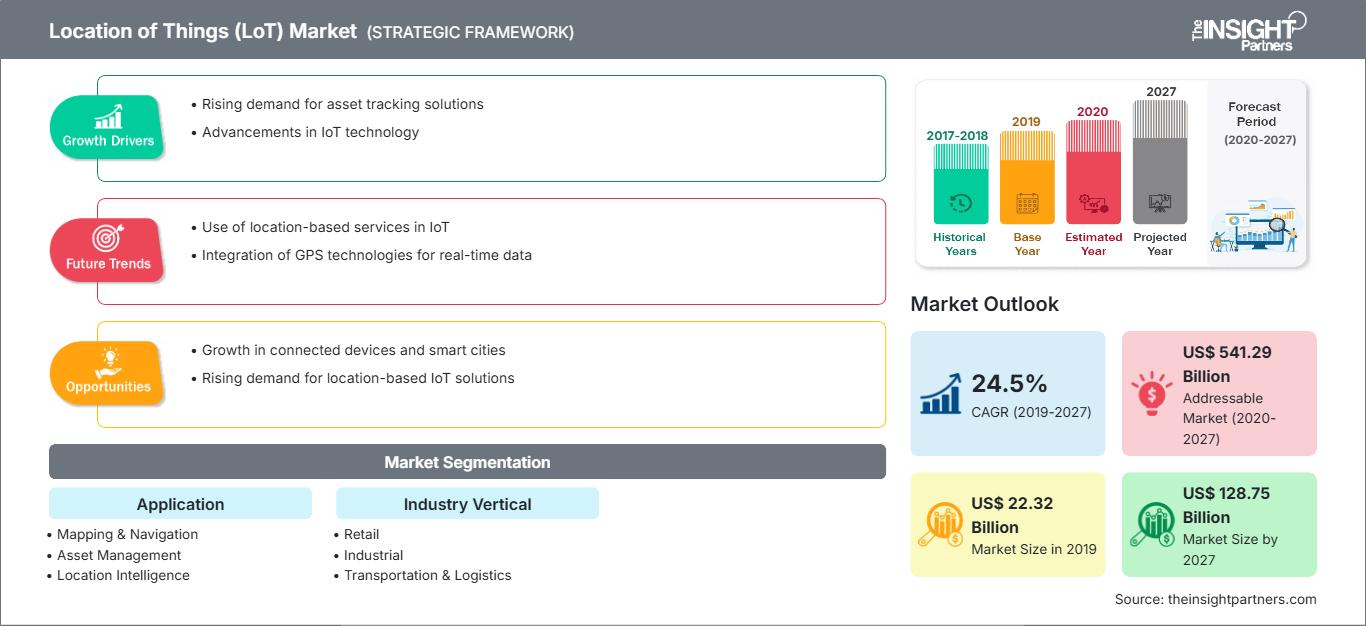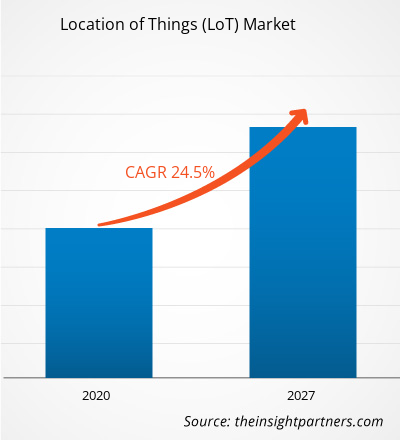Il mercato della localizzazione degli oggetti (LoT) è stato valutato a 22,32 miliardi di dollari nel 2019 e si prevede che raggiungerà i 128,75 miliardi di dollari entro il 2027. Si prevede che il mercato della localizzazione degli oggetti (LoT) crescerà a un CAGR del 24,5% nel periodo di previsione dal 2020 al 2027.
Il mercato globale delle infrastrutture Internet sta vivendo una forte crescita per quanto riguarda gli investimenti per l'introduzione di tecnologie nuove e avanzate per un migliore accesso ai dati in tempo reale. Il mercato della localizzazione degli oggetti è costituito da alcuni attori consolidati in tutto il mondo, che effettuano investimenti significativi o adottano strategie per fornire servizi altamente avanzati agli utenti. Si prevede che i finanziamenti governativi per la ricerca e lo sviluppo e le partnership strategiche tra fornitori di servizi, operatori di rete ed enti governativi consentiranno enormi impennate nel mercato della localizzazione degli oggetti nel periodo di previsione. L'attuale generazione di reti mobili continuerà a modificare il modo in cui le persone accedono alle informazioni e comunicano. L'implementazione della Localizzazione degli Oggetti per la gestione di diverse attività commerciali aggiunge maggiore senso ai dati disponibili. La crescente domanda di connettività IoT, sicurezza, traffico dati mobile e l'espansione delle app mobili portano all'integrazione dell'architettura cloud con le reti mobili per migliorare la fornitura flessibile di servizi ad alta velocità. Gli operatori di marketing possono sfruttare i dati prodotti e percepire la domanda dei consumatori in base alle tendenze e ai modelli osservati.
Il mercato della Localizzazione degli Oggetti a livello globale è stato segmentato in due segmenti principali, tra cui applicazioni e settori verticali. Il segmento delle applicazioni è ulteriormente frammentato in Small Cell, Macro Cell e altri settori: Mapping & Navigation, Asset Management, Location Intelligence e Media & Marketing. Il settore verticale è ulteriormente segmentato in Retail, Industria, Trasporti e Logistica, Pubblica Amministrazione e Servizi di Pubblica Utilità, Difesa, Media & Intrattenimento, Sanità e altri. Geograficamente, il mercato della Localizzazione degli Oggetti è attualmente dominato dalle regioni sviluppate, tra cui il Nord America. Tuttavia, si prevede che il mercato sarà orientato verso l'area APAC. La crescente penetrazione degli smartphone nelle economie in via di sviluppo dell'Asia, unita al rapido sviluppo delle infrastrutture Internet in queste regioni, si stanno rivelando i principali motori della crescita nell'adozione della tecnologia di localizzazione delle cose.
Personalizza questo rapporto in base alle tue esigenze
Potrai personalizzare gratuitamente qualsiasi rapporto, comprese parti di questo rapporto, o analisi a livello di paese, pacchetto dati Excel, oltre a usufruire di grandi offerte e sconti per start-up e università
Mercato della localizzazione delle cose (LoT): Approfondimenti strategici

-
Ottieni le principali tendenze chiave del mercato di questo rapporto.Questo campione GRATUITO includerà l'analisi dei dati, che vanno dalle tendenze di mercato alle stime e alle previsioni.
Il consumo di dati mobili ha registrato una crescita esponenziale negli ultimi anni. A livello globale, il traffico dati è cresciuto a un tasso annuo di oltre il 65% negli ultimi cinque anni. Inoltre, tra il 2018 e il 2023, si prevede che il traffico dati crescerà a un tasso annuo composto di quasi il 40%. Con l'emergere di servizi e dispositivi più avanzati, gli operatori devono aumentare ulteriormente i livelli di qualità del servizio previsti. Pertanto, la domanda per il mercato della localizzazione degli oggetti (LoT) aumenterà anche nel periodo previsto 2020-2027.
Approfondimenti sul mercato basati sulle applicazioni
Il mercato globale della localizzazione degli oggetti, in base alle applicazioni, è suddiviso in mappatura e navigazione, gestione delle risorse, intelligence sulla posizione e media e marketing. Tutti i settori industriali utilizzano strumenti software basati sulla posizione per vari scopi. Lo scopo principale dell'utilizzo di questi strumenti è organizzare i dati ottenuti tramite Internet e utilizzarli in modo significativo. Sono disponibili numerosi dati attraverso numerosi punti dati e l'avvento dell'IoT ha appena accelerato l'esplosione dei dati. Le numerose applicazioni per l'utilizzo di servizi basati sulla posizione sono ampiamente categorizzate nel nostro studio sul mercato dell'IoT.
Approfondimenti di mercato basati sui settori verticali
I dati raccolti nel modello LOT provengono spesso da diversi indirizzi digitali. Migliaia di punti dati comprendono l'indirizzo digitale e includono indirizzi IP, social network, indirizzi email e coordinate GPS, oltre a indirizzi fisici. I dati geospaziali creano preziose opportunità creando previsioni accurate per diversi settori verticali. Quasi tutti i settori verticali hanno iniziato a sfruttare la potenza dei dati geospaziali. Nel nostro studio sul mercato della localizzazione degli oggetti, il mercato è stato quindi segmentato in base al settore verticale in vendita al dettaglio, industria, trasporti e logistica, pubblica amministrazione e servizi di pubblica utilità, difesa, media e... Intrattenimento, sanità e altri settori
Gli operatori che operano nel mercato della localizzazione degli oggetti (LoT) si concentrano su strategie, come iniziative di mercato, acquisizioni e lanci di prodotti, per mantenere le proprie posizioni nel mercato. Ecco alcuni sviluppi da parte dei principali operatori del mercato della localizzazione degli oggetti (LoT):
A febbraio 2019, Skyhook ha collaborato con Qualcomm Technologies Inc., una sussidiaria di Qualcomm Incorporated, per offrire servizi di localizzazione Wi-Fi e di assistenza alla posizione basati sulle piattaforme Qualcomm Snapdragon Wear.
A febbraio 2019, Continual e HERE Technologies hanno collaborato per creare una soluzione integrata pionieristica per gli operatori di rete mobile (MNO), progettata per monitorare e mappare costantemente l'esperienza di connessione degli utenti in movimento sull'intera rete stradale.
Approfondimenti regionali sul mercato della localizzazione delle cose (LoT)
Le tendenze regionali e i fattori che influenzano il mercato della localizzazione degli oggetti (Location of Things, LoT) durante il periodo di previsione sono stati ampiamente spiegati dagli analisti di The Insight Partners. Questa sezione illustra anche i segmenti e la geografia del mercato della localizzazione degli oggetti (Location of Things, LoT) in Nord America, Europa, Asia-Pacifico, Medio Oriente e Africa, America meridionale e centrale.
Ambito del rapporto di mercato sulla localizzazione delle cose (LoT)
| Attributo del rapporto | Dettagli |
|---|---|
| Dimensioni del mercato in 2019 | US$ 22.32 Billion |
| Dimensioni del mercato per 2027 | US$ 128.75 Billion |
| CAGR globale (2019 - 2027) | 24.5% |
| Dati storici | 2017-2018 |
| Periodo di previsione | 2020-2027 |
| Segmenti coperti |
By Applicazione
|
| Regioni e paesi coperti |
Nord America
|
| Leader di mercato e profili aziendali chiave |
|
Densità degli attori del mercato della localizzazione delle cose (LoT): comprendere il suo impatto sulle dinamiche aziendali
Il mercato della localizzazione degli oggetti (Location of Things, LoT) è in rapida crescita, trainato dalla crescente domanda degli utenti finali, dovuta a fattori quali l'evoluzione delle preferenze dei consumatori, i progressi tecnologici e una maggiore consapevolezza dei vantaggi del prodotto. Con l'aumento della domanda, le aziende stanno ampliando la propria offerta, innovando per soddisfare le esigenze dei consumatori e sfruttando le tendenze emergenti, alimentando ulteriormente la crescita del mercato.

- Ottieni il Mercato della localizzazione delle cose (LoT) Panoramica dei principali attori chiave
- Mappatura e navigazione
- Gestione delle risorse
- Intelligence sulla posizione
- Media e marketing
Mercato della localizzazione delle cose (LoT) - per settore verticale
- Vendita al dettaglio
- Industriale
- Trasporti e logistica
- Governo e servizi di pubblica utilità
- Difesa
- Media e intrattenimento
- Sanità
- Altro
Mercato della localizzazione delle cose (LoT) - per settore verticale per area geografica
-
America settentrionale
- Stati Uniti
- Canada
- Messico
-
Europa
- Francia
- Germania
- Spagna
- Regno Unito
- Italia
- Resto d'Europa
-
Asia Pacifico (APAC)
- Cina
- India
- Giappone
- Australia
- Resto dell'APAC
-
MEA
- Arabia Saudita
- Emirati Arabi Uniti
- Sudafrica
- Resto del MEA
-
SAM
- Brasile
- Resto di SAM
Mercato della localizzazione delle cose (LoT) - Profili aziendali
- ESRI
- HERE technologies
- Navizon Inc.
- Qualcomm Incorporated
- skyhook
- Trimble inc.
- Wireless Logic Limited
- Alphabet Inc. (Google)
- Microsoft
- IBM Corporation
- Analisi storica (2 anni), anno base, previsione (7 anni) con CAGR
- Analisi PEST e SWOT
- Valore/volume delle dimensioni del mercato - Globale, Regionale, Nazionale
- Industria e panorama competitivo
- Set di dati Excel
Report recenti
Testimonianze
Motivo dell'acquisto
- Processo decisionale informato
- Comprensione delle dinamiche di mercato
- Analisi competitiva
- Analisi dei clienti
- Previsioni di mercato
- Mitigazione del rischio
- Pianificazione strategica
- Giustificazione degli investimenti
- Identificazione dei mercati emergenti
- Miglioramento delle strategie di marketing
- Aumento dell'efficienza operativa
- Allineamento alle tendenze normative






















 Ottieni un campione gratuito per - Mercato della localizzazione delle cose (LoT)
Ottieni un campione gratuito per - Mercato della localizzazione delle cose (LoT)